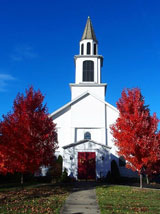
Dear Friends,
The year is fast coming to a close. Thanksgiving and Christmas are just around the corner.
At this writing I am hopeful that we will be able to present our Mission Study to Presbytery on Nov. 7. When approved we will be able to elect the Pastor Nominating Committee and begin the search for a new settled pastor.
This has been quite a year. One of turmoil, and dissension in both our country and throughout the world. The weather seemed to respond to the sense of upheaval and angst with fires and floods the likes of which were unknown in modern history.
We may wonder “What is going on?” Whatever it is, it is effecting the world “out there” and our world “in here” namely our church.
Several months ago Rocky Peters sent me an email proposing that we look at the church from a height of 30,000 feet. It was a lovely and insightful message suggesting that we look at the church from a business model perspective. (I have included it in our Mission Study.)
I think it is important that we look at the church, not just the church, but all faith communities, from a height of at least 30,000 feet, and with a broad historical perspective.
To this end I would like to mention two people who have given much time and thought to getting a handle on what is going on and what to do about it; one is British Rabbi, scholar and philosopher Jonathan Sachs, the other, Paul Nixon a United Methodist Minister and author of the book, “I Refuse to Lead a Dying Church.”
I will briefly try to describe their perspectives, but I invite you to go to rabbisacks.org/cultural-climate-change/ to view Rabbi Sacks recent talk at the Chautauqua Institute, and I will have copies of Paul Nixon’s article in the church office. If you do not have access to the Rabbi’s talk, I would be pleased to have you view it in the office.
But very briefly, Sacks believes that “we are going through one of the most profound revolutions in all of human history and he summed that up as “Cultural Climate Change.” As actual climate change alters weather conditions, cultural climate change is “causing a series of storms in the West” that will “upend conventional notions of faith and the role of religion in society.” He says that religion is the great source of community in the contemporary world, and that without religion, the sense of collective responsibility, of sacrificing for one another in a covenantal relationship, all of which are necessary in a society, would be lost. And that history has shown that when a civilization becomes more secular, consumerist, and individualist, there is a decline in faith, and a subsequent decline in birthrate. Examples given include ancient Greece, Imperial Rome, and Renaissance Italy and even present day Europe. Thus he argues that when a civilization loses its religion it also loses its families, communities and its society. Sobering and thought provoking.
Paul Nixon on the other hand, looks at hundreds of churches in the United States in the last 20 years. We can see that we are not alone in the decline of membership and programs, and the increase in empty classrooms. And as Nixon writes and as we well know, we have gone beyond “the season for tweaking and quick fixes” and that “business as usual is not a viable option,” but there are resources for hope available.
Again, I urge you learn more about these broad 30,000 foot perspectives. The good news that both Rabbi Sachs and Rev. Paul Nixon leave us with, is that there is hope and endless possibility. And that is the same message that we as a church must broadcast to the world.
And in the meantime, come to worship, support one another and love one another. As you prepare for this busy time of year, keep moments for appreciation and gratitude. Call a friend you haven’t seen for a while and invite him or her to come to church with you. Discern your talents and your gifts and how they might best be used to serve this community and this world.
May the Peace of Christ be with you,
Pastor Beth




Comments are closed, but trackbacks and pingbacks are open.